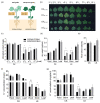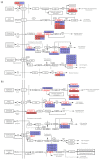Transcriptome Analysis Unravels Key Factors Involved in Response to Potassium Deficiency and Feedback Regulation of K+ Uptake in Cotton Roots
- PMID: 33808570
- PMCID: PMC8003395
- DOI: 10.3390/ijms22063133
Transcriptome Analysis Unravels Key Factors Involved in Response to Potassium Deficiency and Feedback Regulation of K+ Uptake in Cotton Roots
Abstract
To properly understand cotton responses to potassium (K+) deficiency and how its shoot feedback regulates K+ uptake and root growth, we analyzed the changes in root transcriptome induced by low K+ (0.03 mM K+, lasting three days) in self-grafts of a K+ inefficient cotton variety (CCRI41/CCRI41, scion/rootstock) and its reciprocal grafts with a K+ efficient variety (SCRC22/CCRI41). Compared with CCRI41/CCRI41, the SCRC22 scion enhanced the K+ uptake and root growth of CCRI41 rootstock. A total of 1968 and 2539 differently expressed genes (DEGs) were identified in the roots of CCRI41/CCRI41 and SCRC22/CCRI41 in response to K+ deficiency, respectively. The overlapped and similarly (both up- or both down-) regulated DEGs in the two grafts were considered the basic response to K+ deficiency in cotton roots, whereas the DEGs only found in SCRC22/CCRI41 (1954) and those oppositely (one up- and the other down-) regulated in the two grafts might be the key factors involved in the feedback regulation of K+ uptake and root growth. The expression level of four putative K+ transporter genes (three GhHAK5s and one GhKUP3) increased in both grafts under low K+, which could enable plants to cope with K+ deficiency. In addition, two ethylene response factors (ERFs), GhERF15 and GhESE3, both down-regulated in the roots of CCRI41/CCRI41 and SCRC22/CCRI41, may negatively regulate K+ uptake in cotton roots due to higher net K+ uptake rate in their virus-induced gene silencing (VIGS) plants. In terms of feedback regulation of K+ uptake and root growth, several up-regulated DEGs related to Ca2+ binding and CIPK (CBL-interacting protein kinases), one up-regulated GhKUP3 and several up-regulated GhNRT2.1s probably play important roles. In conclusion, these results provide a deeper insight into the molecular mechanisms involved in basic response to low K+ stress in cotton roots and feedback regulation of K+ uptake, and present several low K+ tolerance-associated genes that need to be further identified and characterized.
Keywords: cotton; grafting; nutrient transporter; potassium deficiency; transcription factor.
Conflict of interest statement
The authors declare no conflict of interest.
Figures









Similar articles
-
The Cotton High-Affinity K+ Transporter, GhHAK5a, Is Essential for Shoot Regulation of K+ Uptake in Root under Potassium Deficiency.Plant Cell Physiol. 2019 Apr 1;60(4):888-899. doi: 10.1093/pcp/pcz003. Plant Cell Physiol. 2019. PMID: 30649443
-
Cotton shoot plays a major role in mediating senescence induced by potassium deficiency.J Plant Physiol. 2012 Mar 1;169(4):327-35. doi: 10.1016/j.jplph.2011.10.009. Epub 2011 Dec 9. J Plant Physiol. 2012. PMID: 22154601
-
Mechanism of phytohormone involvement in feedback regulation of cotton leaf senescence induced by potassium deficiency.J Exp Bot. 2012 Oct;63(16):5887-901. doi: 10.1093/jxb/ers238. Epub 2012 Sep 7. J Exp Bot. 2012. PMID: 22962680 Free PMC article.
-
Transcriptome Analysis of Pyrus betulaefolia Seedling Root Responses to Short-Term Potassium Deficiency.Int J Mol Sci. 2020 Nov 23;21(22):8857. doi: 10.3390/ijms21228857. Int J Mol Sci. 2020. PMID: 33238495 Free PMC article.
-
Plant Calcium Signaling in Response to Potassium Deficiency.Int J Mol Sci. 2018 Nov 3;19(11):3456. doi: 10.3390/ijms19113456. Int J Mol Sci. 2018. PMID: 30400321 Free PMC article. Review.
Cited by
-
Integrated transcriptomic and metabolomic analyses reveal key metabolic pathways in response to potassium deficiency in coconut (Cocos nucifera L.) seedlings.Front Plant Sci. 2023 Feb 13;14:1112264. doi: 10.3389/fpls.2023.1112264. eCollection 2023. Front Plant Sci. 2023. PMID: 36860901 Free PMC article.
-
Morphophysiological and transcriptome analysis reveal that reprogramming of metabolism, phytohormones and root development pathways governs the potassium (K+) deficiency response in two contrasting chickpea cultivars.Front Plant Sci. 2023 Jan 11;13:1054821. doi: 10.3389/fpls.2022.1054821. eCollection 2022. Front Plant Sci. 2023. PMID: 36714783 Free PMC article.
-
Arabidopsis transcriptomic analysis reveals cesium inhibition of root growth involves abscisic acid signaling.Planta. 2024 Jan 15;259(2):36. doi: 10.1007/s00425-023-04304-y. Planta. 2024. PMID: 38221596
-
Dynamic transcriptome analysis unravels key regulatory genes of maize root growth and development in response to potassium deficiency.Planta. 2023 Oct 14;258(5):99. doi: 10.1007/s00425-023-04260-7. Planta. 2023. PMID: 37837470 Free PMC article.
-
Transcriptional and Metabolic Responses of Maize Shoots to Long-Term Potassium Deficiency.Front Plant Sci. 2022 Jun 23;13:922581. doi: 10.3389/fpls.2022.922581. eCollection 2022. Front Plant Sci. 2022. PMID: 35812972 Free PMC article.
References
MeSH terms
Substances
Grants and funding
LinkOut - more resources
Full Text Sources
Other Literature Sources
Medical
Miscellaneous

